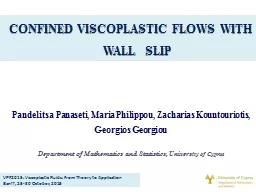PPT-Pandelitsa
Author : luanne-stotts | Published Date : 2016-06-11
Panaseti Maria Philippou Zacharias Kountouriotis Georgios Georgiou Department of Mathematics and Statistics Univers ity of Cyprus VPF2015 Viscoplastic Fluids
Presentation Embed Code
Download Presentation
Download Presentation The PPT/PDF document "Pandelitsa" is the property of its rightful owner. Permission is granted to download and print the materials on this website for personal, non-commercial use only, and to display it on your personal computer provided you do not modify the materials and that you retain all copyright notices contained in the materials. By downloading content from our website, you accept the terms of this agreement.
Pandelitsa: Transcript
Panaseti Maria Philippou Zacharias Kountouriotis Georgios Georgiou Department of Mathematics and Statistics Univers ity of Cyprus VPF2015 Viscoplastic Fluids From Theory to Application.
Download Document
Here is the link to download the presentation.
"Pandelitsa"The content belongs to its owner. You may download and print it for personal use, without modification, and keep all copyright notices. By downloading, you agree to these terms.
Related Documents

